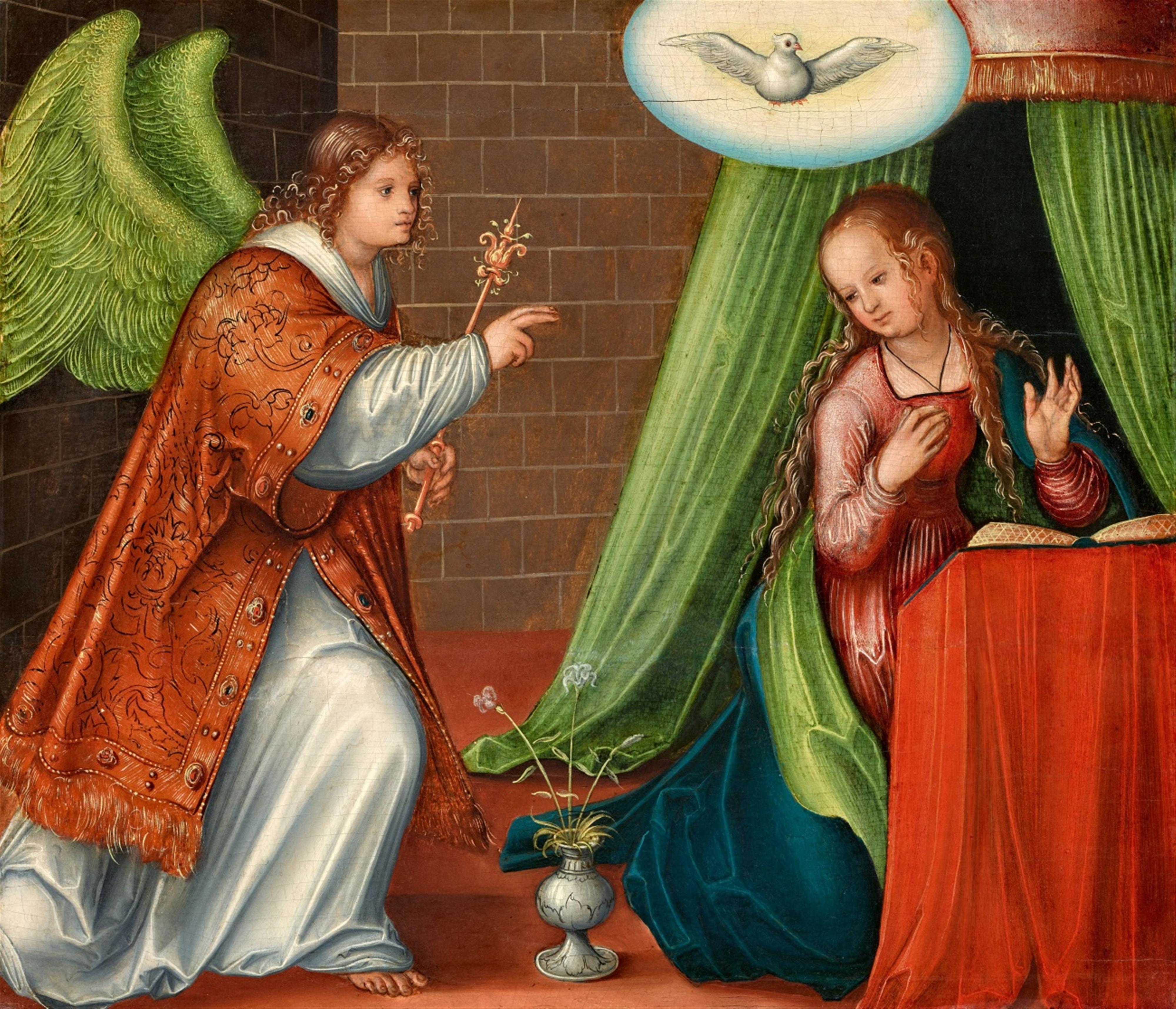Lucas Cranach the Elder, and studio
The Annunciation
Oil on panel, laid down on a second panel. 22.6 x 26.2 cm.
This small, finely painted panel depicts the Annunciation, a rare motif for Cranach's studio. The work has been examined by all relevant Cranach experts and its attribution is documented in numerous examinations.
The oldest expertise available for this work is by Max J. Friedländer, who described it in 1932 as, “[...] a very well preserved work by Lucas Cranach from the time around 1518.” In 1961, Jacob Rosenberg confirmed the attribution of his colleague, who had died three years previously.
The painting was again examined in 1974 as part of the major exhibition of works by Cranach in Basel by Dieter Koepplin, who attributed it to the painter's studio. In the exhibition catalogue, he demonstrates the links between this work and an “Adoration of the Magi” which bears the same dimensions and displays remarkable similarity in colour palette and brushwork.
In April 2021, the painting finally underwent a technological analysis carried out by the Cranach Digital Archive and the Cologne Institute of Conservation Sciences of the TH Cologne (CICS) under the direction of Prof. Dr. Gunnar Heydenreich.
The panel was examined using stereo-microscopy, RF analysis (Niton XLt), x-ray structural analysis, and infrared reflectography (Osiris 900-1700nm).
The infrared reflectography (IRR) showed that the preliminary drawing was carried out with a brush and drawing pen using a greyish-black liquid medium. The outlines and other structures were drawn in very confident strokes. The faces and hands were rendered with particular skill, taking account of the dimensions. The IRR also provided interesting insights into the amendments made to the under-drawing throughout the work's inception. For example, the dove and the messenger's staff held by the angel were slightly reduced in size, the hands and drapery slightly modified, and the decorative motifs on the canopy that were included in the preliminary drawing were not included in the final painted work.
Finally, the x-ray fluorescence analysis was able to detect traces of the following pigments in the painted surface: Lead white, lead-tin-yellow, vermilion, copper green, copper blue and iron oxide/ochre. The paint was applied in layers using brushes. The pattern on the canopy was scratched out of the red lacquer layer using sgraffito technique. The mortar between the bricks in the wall was first accentuated with finely incised lines. The x-ray pictures show that no significant changes were made to the composition between the under-drawing and the painted work.
The analysis demonstrates that the author of this work was very familiar with the materials and techniques used by the Cranach studio. The preliminary drawing is of particularly fine quality, as Prof. Dr. Heydenreich mentions in his report, and it displays similarity to known drawings and preliminary sketches attributed to Lucas Cranach the Elder.
Two of the drapery motifs found in the under-drawing are only cursorily rendered. It was the painter who realised the somewhat uniform patterns of drapery in the clothing, which even repeat themselves in the robe and gown of the Virgin. The hands are also much more finely rendered in the preliminary drawing than in the final work. The particular fineness of the under-drawing combined with the discrepancies between the preliminary drawing and the painted work suggest that Lucas Cranach the Elder himself may have drawn the composition onto the panel, whilst the painting was carried out by a member of the workshop.
The panel is preserved in relatively good and stable condition. The red lacquer and the green pigments are especially well conserved in comparison to other works.
In conclusion of his analysis, Prof. Dr. Heydenreich regards this panel to be a well preserved work by 'Lucas Cranach the Elder and his studio', painted in around 1516 – 1520.
We would like to thank Prof. Dr. Gunnar Heydenreich and Diana Blumenroth M.A. (CICS Cologne) for carrying out the technological analysis of the original work.
Certificate
Max J. Friedländer, Berlin, 2.9.1932 (as Cranach sr.).
Jakob Rosenberg, Ann Arbor/Michigan, 13.1.1961 (as Cranach sr.).
Prof. Dr. Gunnar Heydenreich, Cologne, 5.4.2021 (as Lucas Cranach sr. and studio)
Provenance
Galerie van Diemen & Co., Berlin, before 1932. - Auctioned by Paul Cassirer, Berlin, 20.10.1932, lot 48 (as Cranach sr.). - Katzenelnbogen collection. - Galerie Schaeffer, New York, 1961. - Collection of Dr. H. Becker, Dortmund, 1974. - Subsequently in German family ownership.
Literature
Koepplin, Dieter & Falk, Tilman: Lukas Cranach. Gemälde, Zeichnungen und Druckgraphik, Basel/Stuttgart, 1974-1976, vol. 2, p. 538, no. 391, illus. 285. - Gmelin, Hans-Georg: Exhib. cat. Lukas Cranach der Ältere 1472-1553. Grafik, Bielefeld, 1972, no. 4. - Fritz, Rolf:
Exhibitions
Lukas Cranach der Ältere 1472-1553 - Grafik, Kunsthalle Bielefeld, 23.1.-26.3.1972.
"Lukas Cranach - Gemälde, Zeichnungen, Druckgraphik", Kunstmuseum Basel, 15.6.-8.9.1974.

